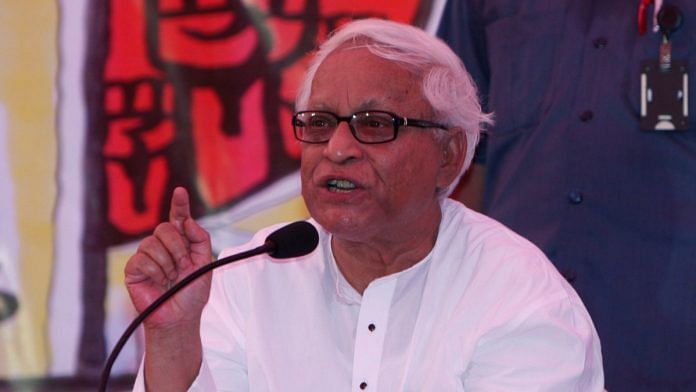Buddhadeb Bhattacharya will go down in the history of the Left in India as the man who lost to Mamata Banerjee. This is a cruel twist for the leader, handpicked by Jyoti Basu as his successor in West Bengal and someone who would stretch the rule of the Communist Party of India (Marxist) even longer into the history books. Instead, he presided over the beginning of the decline in the fortunes of the Left in the country which today rules only Kerala.
Bhattacharya successfully filled the shoes of Basu, five-time West Bengal chief minister, and carried out a series of reforms in his first tenure. It was only in his second tenure as chief minister that his push for industrialisation backfired completely and ended CPM’s 34-year reign in the state.
On his 75th birthday, ThePrint recalls the achievements and setbacks faced by the communist party leader.
Political profile
Bhattacharya was born on 1 March 1944 in North Kolkata. He completed his school education from Sailendra Sarkar Vidyalaya and pursued BA Honours in Bengali from Presidency College.
A revolutionary by nature, Bhattacharya joined the CPM in 1966.
In 1977, he was elected an MLA for the first time from Cossipore in north Kolkata. This was the same year when CPM came to power in West Bengal under the leadership of Basu. Bhattacharya lost from Cossipore to Congress’ Prafulla Kanti Ghosh in the 1982 elections. However, he bounced back five years later and won from the Jadavpur constituency.
He served as minister of information and culture between 1987 and 1996, and as minister of home affairs between 1996 and 1999.
On 6 November 2000, Bhattacharya replaced Basu as West Bengal CM after the latter’s 23-year rule.
First tenure as CM
After Basu decided to step down on health grounds, Bhattacharya, in a smooth transition, was given the opportunity to show his prowess and go into the 2001 elections as an incumbent. He was given the responsibility to rejuvenate the party and bring development in the state.
Little did he know that 10 years down the line Mamata Banerjee’s Trinamool Congress, which had won 60 seats in 2001, would win thrice that number in 2011.
Bhattacharya’s first five-year tenure saw the development of several industries and IT services across the state. He became famous for the “do it now” slogan. Bengal’s IT Policy was formulated in 2003 and the state’s IT industry witnessed 70 per cent growth from 2001 to 2005.
Wipro chairman Azim Premji even went on to call Bhattacharya the best CM in the country.
T.V. Mohandas Pai, then finance director of Infosys, had said, “India’s renaissance in the 21st century will come from Calcutta like it did in the 19th century.”
At this time, the CPM was in alliance with the Congress under the United Progressive Alliance coalition at the Centre.
Bhattacharya’s clean image helped the CPM garner a greater number of seats in the 2006 assembly elections — 235 seats compared to 199 seats in the previous elections.
Also read: George Fernandes, the socialist who wanted to be a priest but ended up a rebel
Nandigram and Nano fiasco
But the push for industrialisation as he sought to take Bengal towards prosperity in his second term backfired.
At a press meet in 2006, Bhattacharya said, “According to classical Marxism, there is a fundamental feud between capital and labour. But here we are practising policies of capitalism, not socialism. We do not want to raise slogans like ‘ladai ladai ladai chai’ (we will have to fight) and close down factories.”
Sensing opportunity, Banerjee amped up her campaign against the Left rule.
The state government ran into major trouble for the first time when inhabitants of Nandigram, West Midnapore, protested against setting up a chemical hub in their village. The crisis acquired national limelight on 14 March 2007 when 14 protesters were killed in Nandigram in police firing.
According to India Today, Bhattacharya’s response to the crisis boomeranged.
“We have paid them back in their own coin,” he said in what proved to a disaster — he was criticised by his own party colleagues as well as then West Bengal governor.
Industrialist Ratan Tata’s Nano car project at Singur was another debacle over issues of land acquisition. Banerjee organised massive protests against forcible acquisition of land. On 3 October 2008, Tata Motors announced moving the project to Gujarat.
Fall and fall of CPM in West Bengal
In the 2011 West Bengal assembly elections, Banerjee’s Trinamool Congress swept the polls and decimated the 34-year-old Left bastion in the state. Banerjee’s party won a total of 184 seats while the CPM was able to manage only 40 seats.
Bhattacharya also lost from the Jadavpur constituency to Trinamool Congress’ Manish Gupta. Even Congress won 42 seats, two more than the Left front.
After five decades, Bhattacharya was relieved of all key responsibilities from the party in 2015.
In the following 2016 assembly elections, CPM was able to win only 29 seats.
Also read: MN Roy, the Indian revolutionary who founded Mexican Communist Party




A good man. Dr Singh held him in high esteem. Land acquisition has become a major stumbling block for industrialisation. Land will be unaffordable under the new LA Act.
The author is biased, stop crystal gazing and do no rule out the revival of the left. What is the basis of saying that the left will never come back to power in WB. Print contributors should be more realistic and stop crystal gazing